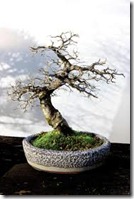 The Japanese have a word, ‘wa’, that roughly translates to ‘harmony’. It refers to relations between individuals, and man and nature. But it can also refer to the elements comprising a work of art. The art of bonsai uses this concept when coordinating the choice of species and style with the container in which the bonsai tree resides.
The Japanese have a word, ‘wa’, that roughly translates to ‘harmony’. It refers to relations between individuals, and man and nature. But it can also refer to the elements comprising a work of art. The art of bonsai uses this concept when coordinating the choice of species and style with the container in which the bonsai tree resides.
Color, material and above all shape and size are considered when matching the right pot to a given tree. Given the variety of tastes in the world, there are no agreed upon rigid rules, but tradition and a sense of symmetry heavily influence the choice. Each is selected to complement the other, giving balance to the overall design.
But there are practical factors to consider, as well, first and foremost.
The size of the pot must physically balance the weight of the moist soil and the tree. Bonsai are typically displayed on a stand or bench or shelf and, being small, are easily tipped over if the pot is too small and light, or the tree is out of balance.
Style affects not only the aesthetic of the bonsai, but this practical factor as well. A kengai (cascade) or han-kengai (semi-cascade) has a trunk and/or branches that travel out from the ‘box’ of the pot. In the case of the kengai, it dips below the plane of the base of the tree, emulating a tree near a cliff under heavy snowfall.
As a result of this style, a too small pot – which holds less soil and provides a smaller base – will put the tree and pot at risk of falling off the display. Bonsai are fragile and years of effort can be lost by a simple accident.
Also, the pot must hold enough soil to accommodate the roots with ample space for growth of two years or so. Normally, a bonsai tree will be re-potted after that time, in order to refresh the soil, trim the roots and possibly increase the size of the tree.
A pot must have a hole in the bottom with a mesh screen in order to allow for proper drainage. The screen can become clogged if the mesh is too small, and allow soil leakage out the bottom if too large.
The tray underneath or attached as an integral part of the pot must be large enough to allow for overflow. Under-watering a bonsai tree can easily kill it, just as over-watering can. And, the easiest way to over-water one is to allow inadequate drainage, worsened by having the bottom continually in water from a tray that’s too shallow or narrow.
The specific sized pot that’s correct for the tree will be affected, too, by species. Flowering and fruiting trees require more water and tolerate wetter conditions. Conifers, such as white pine, do better with a drying period between watering.
Experience and a personal aesthetic will determine the specific pot that’s best to choose. But fortunately for the enthusiast, there are many good examples around to serve as a guideline or stimulus to the imagination. Some bonsai trees live as long as 200 years, and photos of them are readily available.

Deprecated: strpos(): Passing null to parameter #1 ($haystack) of type string is deprecated in /home/agriviek8Qv/agriviet.net/public_html/wp-includes/comment-template.php on line 2522